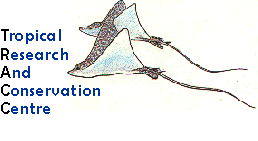|
|
|
|
Effects of blast fishing on coral reef biodiversity
|
 |
|
|
|
| Our
surveys showed that on regularly bombed reefs, fish diversity was reduced
to less than half and actual numbers of benthic living fish species were
reduced to less than 10% of expected findings.
Counts of butterfly fish species are used by Reefcheck globally as an indicator of aquarium fish collecting. This does not occur legally in Sabah and to our knowledge, does not occur illegally. However, butterfly fish species were obviously an indicator of overall reef health or biodiversity (Roberts, Ormond et al. 1988). The figure below shows the numbers of butterfly fish species on a variety of reefs. Not surprisingly, badly damaged reefs had few butterfly fish species, while unfished / protected reefs had a very large number of species.
|
||
Butterfly species (Chaetodontidae) found on various reefs in Sabah. |
Gleaning fisheries
| Invertebrates were also severely
affected by the environmental damage from blast fishing.
Many clams (Tridacna
& Hippopus spp.) had been
affected by the direct effects of blast fishing and were found as
empty buried shells or as shells semi-buried and/or overturned.
Invertebrates were also being heavily collected: sea cucumbers, clams,
triton shells and lobsters were all absent or severely reduced on all but
a few reefs.
The value of protected reefs was shown clearly by the abundance of giant clams. One third of the sites surveyed (32.6%) had no clams while four sites on Layang Layang had over 30 clams per transect and the best site had over 50 clams per transect. Together, Layang Layang and Sipadan had more than 75% of the total giant clams found at all the sites. |
THE NAUTILUS IS COLLECTED FOR ITS SHELL AND SOLD AS A TOURIST CURIO. |
LOBSTERS ARE HEAVILY FISHED AND THEIR NUMBERS HAVE DECLINED DRASTICALLY. |
Fishers
on Chambers Reef (close to Pulau Jambongan) were observed collecting sea
cucumbers and clams for food as well as other molluscs for tourist curios.
The reef was a small patch reef
with a shallowest depth of 8 metres.
It had obviously been harvested for clams before since there were
abundant empty shells which lacked the brilliant white colour of the
freshly killed animal.
The fishing technique employed was for divers using hookah gear to swim and search around the reef. The fishers were using home made masks or goggles and plywood fins and were breathing directly from the end of an air pipe supplied with compressed air from a “hookah” (car tyre) compressor located on the boat. The boat had two compressed air lines of 200m each and the boat simply followed the divers who pulled the air hoses along behind themselves. Each diver made approximately 30-40 minute dives on a rotation basis, the boat had 4 divers and for the 4 hours of observation two divers were in the water at all times. |
|
Clam meat was extracted from the shell on the bottom using a sharp knife that was used to cut the adductor muscle from one of the two shells before the clam could react. The other adductor was then cut and the tissue extracted from the shells. Clams were caught at rates from 10 to 16 per hour. Sea cucumbers of all species were collected by hand at a rate of 45-62 per hour. The boat had no ice and both the clams and the sea cucumbers were preserved by drying in a charcoal fired 45 gallon (220l) oil drum brazier.
During our surveys, all forms of fishing and reef raiding were observed, even Muro Ami, a destructive coral smashing technique was seen.
GIANT CLAMS ARE HARVESTED, EVEN THOUGH THEY ARE PROTECTED IN SABAH. |
|
|BLAST FISHING| |BLAST FISHING FREQUENCY| |ECONOMICS| |BLAST FISHING REGULATIONS| |EFFECTS ON BIODIVERSITY|
|EFFECTS ON CORAL REEFS| |ECOTOURISM PROTECTION|

![]()